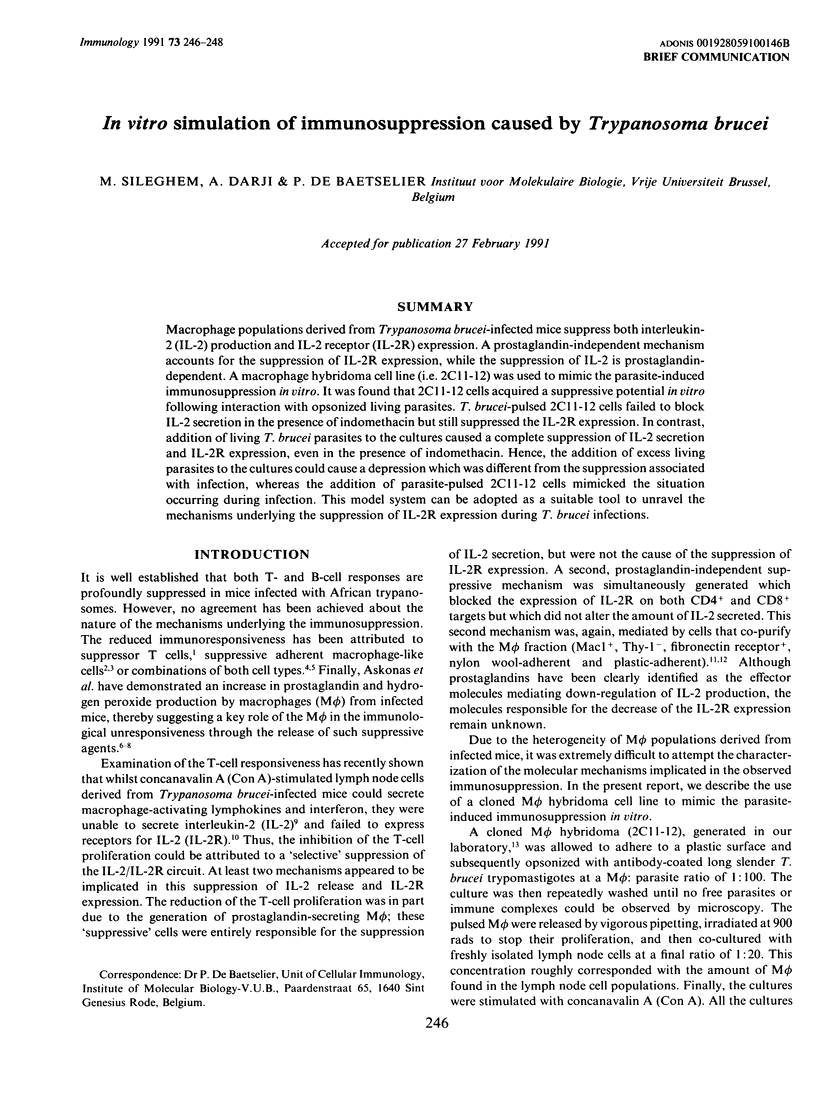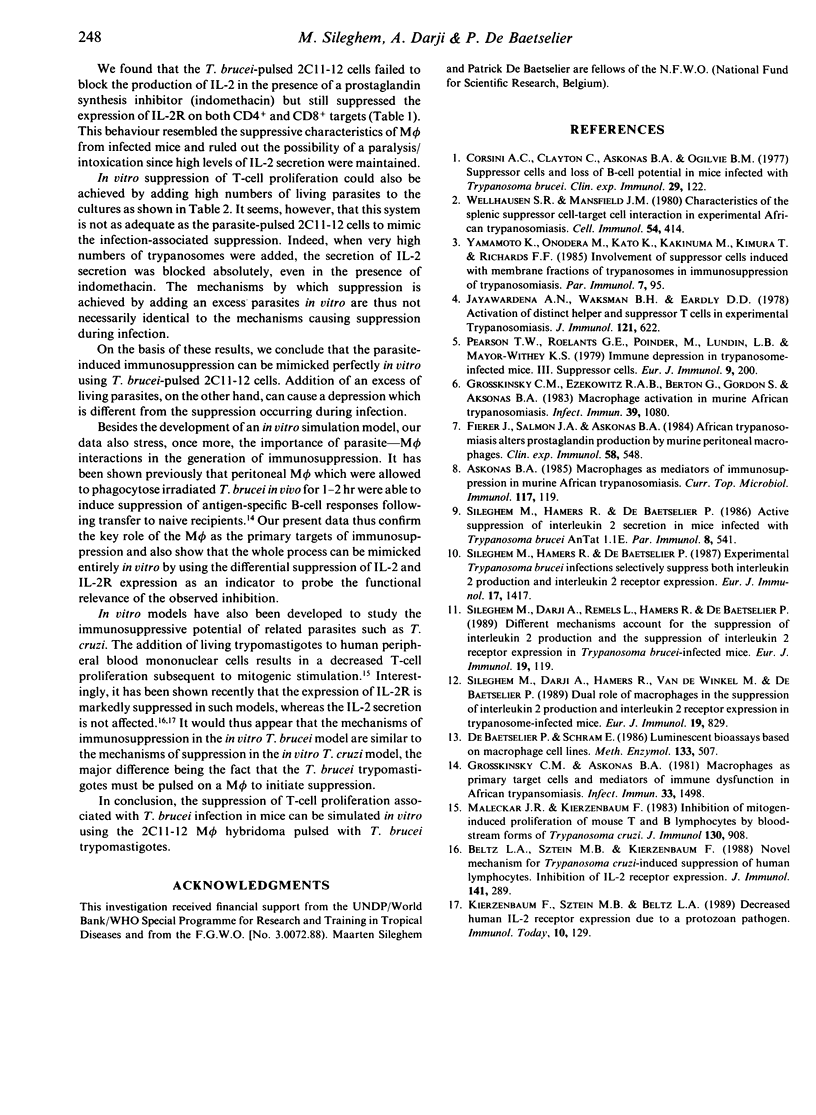Abstract
Macrophage populations derived from Trypanosoma brucei-infected mice suppress both interleukin-2 (IL-2) production and IL-2 receptor (IL-2R) expression. A prostaglandin-independent mechanism accounts for the suppression of IL-2R expression, while the suppression of IL-2 is prostaglandin-dependent. A macrophage hybridoma cell line (i.e. 2C11-12) was used to mimic the parasite-induced immunosuppression in vitro. It was found that 2C11-12 cells acquired a suppressive potential in vitro following interaction with opsonized living parasites. T. brucei-pulsed 2C11-12 cells failed to block IL-2 secretion in the presence of indomethacin but still suppressed the IL-2R expression. In contrast, addition of living T. brucei parasites to the cultures caused a complete suppression of IL-2 secretion and IL-2R expression, even in the presence of indomethacin. Hence, the addition of excess living parasites to the cultures could cause a depression which was different from the suppression associated with infection, whereas the addition of parasite-pulsed 2C11-12 cells mimicked the situation occurring during infection. This model system can be adopted as a suitable tool to unravel the mechanisms underlying the suppression of IL-2R expression during T. brucei infections.
Full text
PDF


Selected References
These references are in PubMed. This may not be the complete list of references from this article.
- Askonas B. A. Macrophages as mediators of immunosuppression in murine African trypanosomiasis. Curr Top Microbiol Immunol. 1985;117:119–127. doi: 10.1007/978-3-642-70538-0_6. [DOI] [PubMed] [Google Scholar]
- Beltz L. A., Sztein M. B., Kierszenbaum F. Novel mechanism for Trypanosoma cruzi-induced suppression of human lymphocytes. Inhibition of IL-2 receptor expression. J Immunol. 1988 Jul 1;141(1):289–294. [PubMed] [Google Scholar]
- Corsini A. C., Clayton C., Askonas B. A., Ogilvie B. M. Suppressor cells and loss of B-cell potential in mice infected with Trypanosoma brucei. Clin Exp Immunol. 1977 Jul;29(1):122–131. [PMC free article] [PubMed] [Google Scholar]
- De Baetselier P., Schram E. Luminescent bioassays based on macrophage cell lines. Methods Enzymol. 1986;133:507–530. doi: 10.1016/0076-6879(86)33087-8. [DOI] [PubMed] [Google Scholar]
- Fierer J., Salmon J. A., Askonas B. A. African trypanosomiasis alters prostaglandin production by murine peritoneal macrophages. Clin Exp Immunol. 1984 Dec;58(3):548–556. [PMC free article] [PubMed] [Google Scholar]
- Grosskinsky C. M., Ezekowitz R. A., Berton G., Gordon S., Askonas B. A. Macrophage activation in murine African trypanosomiasis. Infect Immun. 1983 Mar;39(3):1080–1086. doi: 10.1128/iai.39.3.1080-1086.1983. [DOI] [PMC free article] [PubMed] [Google Scholar]
- Jayawardena A. N., Waksman B. H., Eardley D. D. Activation of distinct helper and suppressor T cells in experimental trypanosomiasis. J Immunol. 1978 Aug;121(2):622–628. [PubMed] [Google Scholar]
- Kierszenbaum F., Sztein M. B., Beltz L. A. Decreased human IL-2 receptor expression due to a protozoan pathogen. Immunol Today. 1989 Apr;10(4):129–131. doi: 10.1016/0167-5699(89)90246-6. [DOI] [PubMed] [Google Scholar]
- Maleckar J. R., Kierszenbaum F. Inhibition of mitogen-induced proliferation of mouse T and B lymphocytes by bloodstream forms of Trypanosoma cruzi. J Immunol. 1983 Feb;130(2):908–911. [PubMed] [Google Scholar]
- Pearson T. W., Roelants G. E., Pinder M., Lundin L. B., Mayor-Withey K. S. Immune depression in trypanosome-infected mice. III. suppressor cells. Eur J Immunol. 1979 Mar;9(3):200–204. doi: 10.1002/eji.1830090306. [DOI] [PubMed] [Google Scholar]
- Sileghem M., Darji A., Hamers R., Van de Winkel M., De Baetselier P. Dual role of macrophages in the suppression of interleukin 2 production and interleukin 2 receptor expression in trypanosome-infected mice. Eur J Immunol. 1989 May;19(5):829–835. doi: 10.1002/eji.1830190508. [DOI] [PubMed] [Google Scholar]
- Sileghem M., Darji A., Remels L., Hamers R., De Baetselier P. Different mechanisms account for the suppression of interleukin 2 production and the suppression of interleukin 2 receptor expression in Trypanosoma brucei-infected mice. Eur J Immunol. 1989 Jan;19(1):119–124. doi: 10.1002/eji.1830190119. [DOI] [PubMed] [Google Scholar]
- Sileghem M., Hamers R., De Baetselier P. Experimental Trypanosoma brucei infections selectively suppress both interleukin 2 production and interleukin 2 receptor expression. Eur J Immunol. 1987 Oct;17(10):1417–1421. doi: 10.1002/eji.1830171005. [DOI] [PubMed] [Google Scholar]
- Wellhausen S. R., Mansfield J. M. Characteristics of the splenic suppressor cell--target cell interaction in experimental African trypanosomiasis. Cell Immunol. 1980 Sep 1;54(2):414–424. doi: 10.1016/0008-8749(80)90221-x. [DOI] [PubMed] [Google Scholar]
- Yamamoto K., Onodera M., Kato K., Kakinuma M., Kimura T., Richards F. F. Involvement of suppressor cells induced with membrane fractions of trypanosomes in immunosuppression of trypanosomiasis. Parasite Immunol. 1985 Mar;7(2):95–106. doi: 10.1111/j.1365-3024.1985.tb00062.x. [DOI] [PubMed] [Google Scholar]


